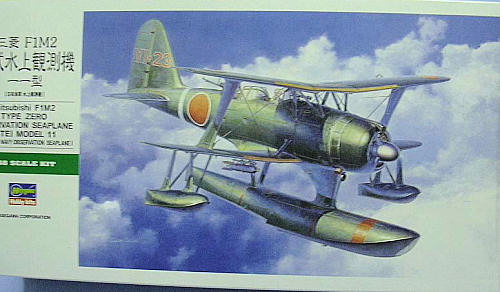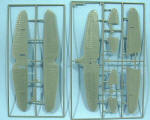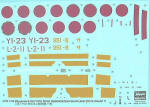
| KIT #: | 19196 (Jt 96) |
| PRICE: | 2800 yen from www.hlj.com |
| DECALS: | Three options |
| REVIEWER: | Tom Cleaver |
| NOTES: | New mold kit, be sure to get the 1200 yen optional rigging set. |

| HISTORY |
In 1936, the Imperial Japanese Navy
issued specifications for a new two-seat reconnaissance seaplane that could be
carried and launched from warships.
The performance specified in terms of range and speed
was far in advance of that offered by such aircraft as the “Alf” or the “Dave,”
which then currently equipped the light reconnaissance units.
The submission by Mitsubishi took
the “traditional seaplane companies” like Kawanishi by surprise, a surprise that
only grew with the F1M1 Type 0 was ordered into production in 1940 with the
designation "Type Zero Observation Seaplane."
Easily one of the best-looking
float seaplanes ever built, the F1M1 and F1M2 surprised the daylights out of
Allied fighter pilots who ran across what became known to the Allies as “Pete”
during the air battles of 1942.
At least one American Marine ace was shot down over the
Solomons by the surprising F1M2.
The airplane was powered by the
Nakajima Hikari MK1 radial engine of 820 hp, giving a maximum speed of 230 mph
and an operating range of up to 670 miles when overloaded. Armed with 3 x 7.7 mm
machine guns - 2 fixed forward-firing weapons and one flexible rear-firing gun,
and two 132 pound bombs, the F1M2 was well-armed for an aircraft in its class
and outperformed most other airplanes in this class.
It was also maneuverable enough to engage in dogfights.
1,118 F1M1 and F1M2s were built by the time production
ceased in 1944. The Navy designation wa
Though originally built as a
catapult-launched reconnaissance float plane, the F1M performed well as an
area-defense fighter, convoy escort, bomber, anti-submarine, ocean patrol,
rescue and transport. The “Pete” was encountered in first-line combat in the
Aleutians and Solomons and was found aboard Japanese warships and in second-line
units throughout the war.
One of the first combats between
American forces and the F1M occurred on April 8-9, 1942, when PT-34 was lost to
attack by several of these aircraft.
PT-34 was part of the famous Motor
Torpedo Boat Squadron Three, commanded by LT John D. Bulkeley and based in the
Philippines from late 1941 through April 1942.
PT-34 was commanded by the Squadron Executive Officer,
Lt(jg) Robert B. Kelly, and saw action from the outbreak of war.
She was one of the three PT boats that evacuated Douglas
MacArthur and his staff from Corregidor on March 12, 1942, as part of the
operation to get MacArthur to Australia.
PT-34 carried several senior staff officers, including
Admiral Francis W. Rockwell, General Richard Marshall (Deputy Chief of Staff,
USAFFE), Col. Charles P. Stivers (G-1, USAFFE), and Capt. Joseph McMicking
(Philippine Army, Asst. G-2, USAFFE).
On the night of April 8, 1942,
PT-34 and PT-41 attacked
the Japanese cruiser Kuma
and
torpedo boat Kiji off Cebu.
Both American boats reported seeing multiple torpedo
hits on the Kuma, but according to
Japanese Navy records the Kuma was hit
in the bow by one of the torpedoes fired by PT-34, which
failed to detonate.
In the aftermath of the attack, F1M floatplanes from the seaplane tender Sanuki Maru were sent to search for the Americans. Four of the floatplanes found and sank PT-34 near Kauit on the morning of April 9, 1942 by dive bombing and strafing. PT-34 suffered one killed and three wounded out of the six man crew. Lt(jg) Kelly was unwounded, and was among the last survivors of MTBRon-3 to be evacuated to Australia a week later. PT-34's Executive officer, Ensign Iliff David Richardson, remained behind in the Philippines with the guerrilla forces for the next two years. His stirring account of his experiences with the Filipino resistance was published in 1945 as “An American Guerrilla in the Philippines,” written with Ira Wolfert, and made into a movie of the same name in 1950, directed by Fritz Lang and starring Tyrone Power. I read the book and saw the movie as a kid, and recently saw the movie again on Turner Classic Movies. Both book and movie are worth checking out.
| THE KIT |
 Previously, there has only been one
“Pete” in any scale ap
Previously, there has only been one
“Pete” in any scale ap proximating
1/48, that being the 1/50 kit originally released by Tamiya 40 years ago, which
has been in and out of production ever since.
While good for its time, the Tamiya kit required major
work and a scratchbuilt cockpit to get a good model, and then it was still too
small.
As I recall, Hasegawa released a 1/72 “Pete” 20 years ago or so.
proximating
1/48, that being the 1/50 kit originally released by Tamiya 40 years ago, which
has been in and out of production ever since.
While good for its time, the Tamiya kit required major
work and a scratchbuilt cockpit to get a good model, and then it was still too
small.
As I recall, Hasegawa released a 1/72 “Pete” 20 years ago or so.
You can sell your Tamiya “Pete” on
eBay now.
This new kit by Hasegawa is “definitive.”
The fully-detailed cockpit is so good that only a
confirmed “resinaholic” will have to get any aftermarket parts for this.
The surface detail is restrained, other than for the
fabric areas, which in my view are overdone with huge “hills and valleys.”
However, this is far from a deal-breaker, and any
modeler who can’t stand this detail will have no trouble removing it with a
sanding stick in a few minutes.
Decals are included for three aircraft, and include the
yellow “ID stripes” for the wings, which means you will not have to paint and
mask these.
These decals follow the new Hasegawa tradition of doing the white
areas as actual white, and look nice and thin.
 The photoetch rigging is provided
separately, as was the case with the Tamiya Swordf
The photoetch rigging is provided
separately, as was the case with the Tamiya Swordf
One thing I would suggest is
putting some weights in the nose of the main float, in order to avoid
tail-sitting when the model is displayed on its beaching gear.
I found this problem with a Rufe kit, since the main
wheels of the beaching gear are under what would be the center of gravity of the
real thing, leaving a lot of model behind that line.
| CONCLUSIONS |
The F1M2 Type Zero observation
Seaplane is definitely one of the best-looking float planes ever built.
This kit from Hasegawa is “definitive.”
I have already started preliminary work on it and it has
excellent fit and an overall design that ensures it will be both easy and nearly
impossible to misalign.
Highly recommended.
Review kit courtesy HobbyLink Japan. Get yours at “Japanese prices” at www.hlj.com For current exchange rates, visit www.xe.com
March 2009
If you would like your product reviewed fairly and quickly, please contact me or see other details in the Note to Contributors.